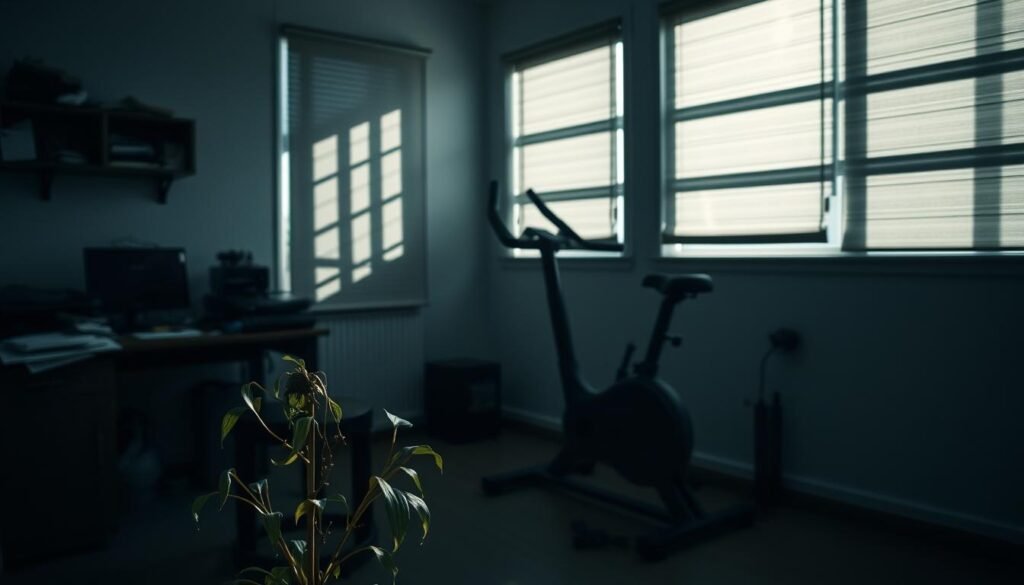Did you know sitting a lot increases depression risk by 31%? Nowadays, more people live a sedentary life. This raises concerns about how little movement affects our mental health. Activities like too much TV watching can lead to depression, studies say. But, using the computer in an engaging way might not be as harmful.
We will look at how not moving much relates to feeling low. This article uses recent research and data. It shows why staying mentally healthy is crucial. You can learn more by checking a recent study. It talks about sitting too much and depression.
It’s also key to take care of yourself to stay mentally well. The tips here can improve your mood. Knowing this helps us choose better ways to live. It keeps us healthy in body and mind.
Key Takeaways
- Sedentary behavior is linked to an increased risk of depression.
- Inactivity and physical activity have unique implications for mental health.
- Reducing sedentary time may significantly improve mental wellness.
- Engaging in physically active behaviors can counteract the adverse effects of a sedentary lifestyle.
- Strategies for self-care, including exercise, nutrition, and social support, can promote mental health.
Understanding Sedentary Lifestyle
A sedentary lifestyle means sitting or lying down a lot with little exercise. It often involves sitting for more than six hours a day. This can be bad for both your body and your mind.
Definition of Sedentary Behavior
Sedentary behavior is when you don’t move much, like watching TV or using computers. It’s common in jobs that require sitting, such as for office workers or drivers. Research shows that not moving can increase the risk of mental health problems.
Common Sedentary Activities
Examples of common sedentary activities include:
- Watching television for extended periods
- Working on computers or tablets
- Driving long distances
- Engaging in prolonged sessions of leisure reading
- Playing video games
- Sitting during commutes, whether public or private
Spending too much time in these activities can harm your health. Many people find themselves in these patterns, especially where moving around is hard. Recent studies show why we need to move more for better mental health. To learn more about cutting down sedentary time, click here.
Statistics on Sedentary Behavior
A sedentary lifestyle is a big concern for public health, especially in older adults. Data shows many older folks often sit too much. For instance, those 65 and older watch TV for four hours a day on average. Watching TV for six or more hours can make depression more likely. This shows sitting too much might hurt our mental health.
Prevalence of Sedentary Lifestyle in Adults
A shocking 88% of older people spend lots of time sitting, like watching TV or surfing the web. The count of inactive adults is rising globally. For example, a quarter of them don’t exercise enough. In America, about 8.4% of adults feel depressed. Depression is even more common, around 10.97%, in adults with chronic kidney disease. Sitting too much is linked to a 1.69 times higher risk of severe depression.
Trends Over Time
Over years, people have become less active and more sedentary. This bad trend highlights the need to promote more activity. The expected rise in dementia by 2030 makes this even more urgent. As sitting too much becomes usual, we need to understand how it affects mental health. This is key to making public health plans work better.
Health Consequences of a Sedentary Lifestyle
Living a sedentary lifestyle can lead to major health issues, both in your body and mind. Knowing the risks can help us fight them to stay healthy. Sitting too much can cause serious health conditions that affect your life deeply.
Physical Health Risks
A sedentary lifestyle raises the chance of getting chronic diseases. Studies show that not moving enough can make you more likely to get sick with:
- Cardiovascular diseases
- Obesity
- Type 2 diabetes
- Muscular weakness and bone health deterioration
In the U.S., under 20% of jobs are active, leading many to sit all day. This increases the dangers of being inactive, like dying early. Moving regularly is key to strong muscles, good metabolism, and a strong immune system.
Impact on Overall Well-being
Being inactive hurts more than just your body. It’s linked to bad mental health outcomes, including stress, anxiety, and being very tired. For example, many high schoolers feel depressed, but those who are active have better chances of not feeling this way.
Too much screen time is also linked to feeling down. But doing any physical activity, even standing or walking a bit at work, can really improve your mood and mental health.
Mental Health and Its Risks
Many people are facing mental health issues, and depression rates are climbing worldwide. Nearly 350 million folks are dealing with depression, as reported by the World Health Organization. It’s important to know what leads to depression. Not moving much can really affect mental health. This makes it key to understand how staying still can lead to depression and anxiety.
The Prevalence of Depression
Sitting too much can really impact mental health. Studies have found that people who sit a lot may be more depressed. If someone sits for over four hours, they might see an increase in weight and body fat. This can make depression worse.
Research shows that sitting for long times without a break can make depression symptoms stronger. People who move more often have a lower chance of feeling depressed. This information shows we need to get up and move to stay well mentally.
Connection Between Mental Health and Sedentary Behavior
There’s a strong link between sitting too much and poor mental health. More sitting is connected to weaker muscles and feeling down. It’s clear: the more you sit, the higher the risk for depression, especially in the young.
But there’s hope. Moving around, even moderately, can lower depression, especially in kids. Simple activities, like daily walks, can make a big difference. They can help prevent depression as kids grow into teens. Moving is key in fighting against sitting too much.

| Behavior Duration | Associated Risk of Depression |
|---|---|
| Less than 2 hours | Lower risk |
| 2-4 hours | Moderate risk |
| 4-8 hours | Higher risk |
| More than 8 hours | Severe risk |
To wrap up, knowing how sitting too much affects depression is crucial. Encouraging everyone to be more active can improve mental health. It helps bring about a healthier lifestyle for people of all ages.
Evidence Linking Sedentary Lifestyle and Depression
Recent research has shown a clear link between being inactive and feeling depressed. Studies have found that certain inactive behaviors, especially ones that don’t require much thought, can greatly affect our mental health. It’s important to understand these behaviors to prevent depression.
Research Findings on Sedentary Behavior and Depression
A large study looked at data from 12 studies with over 128,000 people. It found a strong connection between inactivity and depression. Watching TV, like the 167.1 million Netflix subscribers do, is linked to higher depression rates. People in the study were inactive for about five and a half hours a day. About 6.3% of them often felt depressed at the start.
By doing something engaging instead of passive activities for 30 minutes a day, people could lower their depression risk by 5%. This change could help prevent Major Depressive Disorder (MDD).
Epidemiological Studies Insights
Studies show that sitting too much can lead to depression. For example, over 22,500 adults were mostly inactive but did about 37 minutes of light or intense exercise daily. Interestingly, 1.4% of people who weren’t depressed at first got MDD later. This shows that our daily habits matter for our mood.
Knowing the early signs of mood problems can help manage stress and keep our minds healthy. For more on what causes depression and how lifestyle matters, check out this resource.
| Behavior Change | Effect on Depression Risk |
|---|---|
| 30 mins passive to 30 mins mentally active | Reduced risk by 5% |
| Replace sedentary with light/moderate activity | Reduced likelihood of symptoms by 5% |
Potential Risk Factors
To stop depression linked to sitting around too much, we need to know the risks. Age plays a big part, as older folks often do less moving and more sitting. People with less money are also at risk because they don’t have easy ways to get active.
Age and Gender Considerations
How old you are matters a lot when looking at depression risks. Studies show that people over 65 watch TV for about four hours a day. Watching too much TV can make them feel more depressed, especially women. Knowing these facts can help us make better plans to help different people.
Socioeconomic Factors
Your economic situation can push you towards a life with less movement. If you don’t have much money, it might be hard to find places to exercise. This can lead to feeling down because you’re not moving enough. So, we must think about money differences when we try to get people moving more.

| Age Group | Average TV Time (hrs/day) | Risk of Depression |
|---|---|---|
| Under 18 | 2 | Moderate |
| 18-24 | 3 | Increased |
| 25-64 | 3.5 | Significant |
| 65 and older | 4 | High |
Sedentary Lifestyle and Its Link to Depression
The link between being inactive and feeling depressed is becoming more clear. There are several mechanisms of influence that show how not moving much can make mental health issues worse. It’s important to understand this to help people who don’t move much feel better.
Mechanisms of Influence
Being alone a lot can happen when people sit for too long without doing much. Talking and spending time with others is important for feeling happy. When people don’t move around much, they don’t get to hang out with friends as much. This can make them feel lonely and sad.
Not sleeping well is another problem for those who don’t move around much, making them more likely to feel depressed. Not getting enough exercise can also make people feel down. Physical activity makes people happier and helps them connect with others. But a study in 2021 found that too much sitting can still be bad for your mood. This is true even for those who exercise the recommended amount but sit a lot during the day.
Specific Behaviors Contributing to Depression
There are certain things people do that make them more likely to feel depressed. Spending too much time on screens is a big one. A study in 2020 with over 28,000 college students found a clear link between screen time and feeling anxious or depressed. Another study from 2013 showed that exercising for 30 minutes, 3 to 5 times a week, can make people feel less anxious. However, those who don’t balance screen time with exercise might face more mental health issues.
Making changes in these habits is key to reducing the risk of depression from a sedentary lifestyle. Encouraging people to be more active can push them towards behaviors that improve their mental health.
| Study Year | Findings |
|---|---|
| 2015 | Moderate evidence indicates a correlation between sedentary behavior and increased anxiety. |
| 2018 | Most young adults sit for more than 9 hours a day. |
| 2020 | Sedentary behaviors linked to anxiety, depression, and suicidal thoughts in college students. |
| 2021 | Even with adequate exercise, prolonged sitting negatively affects mental health. |
Strategies to Combat Sedentary Lifestyle
To fight a sedentary lifestyle, embracing practical physical activity is key. Moving more throughout the day boosts both your body and mind. It also lessens the risks linked to sitting too much.
Integrating Physical Activity into Daily Routine
Making small changes to your daily routine can lead to a more active life. You can start with:
- Standing desks: They allow you to stand while working.
- Regular movement breaks: Taking time to walk or stretch every hour helps.
- Active meetings: Choosing to have meetings while walking adds movement to your day.
These strategies are simple to include in your schedule. They help promote a healthy mindset and better health.
Creating an Active Work Environment
Employers have a big role in making the workplace active. Offering incentives for being active encourages employees to join in. Some ideas are:
- Group fitness classes: They promote team building and fitness after work.
- Walking challenges: Competitions to see who can walk the most encourage movement.
- Movement-friendly office designs: Spaces that promote stretching and teamwork are beneficial.
Active workplaces help improve employee health, productivity, and happiness.

Encouraging Mental Wellness Through Movement
Moving daily is key for our mental well-being. Regular exercise helps us in many ways, improving our mind’s health. It cuts down on anxiety and depression symptoms. This is especially important in our busy lives.
The Role of Exercise in Mental Health
Exercise is well-known for its good effects on mental health. Studies show it can lower the chances of feeling depressed or anxious. Those who exercise regularly feel better about themselves and are happier.
A review in 2018 found that aerobic exercise is particularly good for fighting depression. Just 30–35 minutes of light aerobic exercise, three to five times a week, can make us feel more positive over time.
Community Programs and Resources
Community programs are vital in helping people move more and feel better. They offer support and the chance to meet others with similar goals. Activities in groups not only fight off sitting too much but also inform people about mental health help in their area.
These programs provide social backing and encourage regular exercise, designed for all sorts of people. Taking part means you get all the exercise benefits and grow stronger mentally, too.
| Exercise Type | Benefits | Recommended Frequency |
|---|---|---|
| Aerobic Exercise | Reduces symptoms of depression and anxiety | 150 minutes per week |
| Yoga | Enhances mood and reduces stress | 3-5 times per week |
| Mindfulness/Meditation | Increases relaxation response and emotional well-being | Daily practice recommended |
Conclusion
The link between not moving much and struggling with mental health, like depression, is clear. Research looked at seven studies. It found that people, even with Parkinson’s disease, often spend around 10 hours a day inactive. This much inactivity is linked to more depression and worse brain function.
This article shows that not being active is a big public health issue. Over 31% of adults around the world don’t move enough. We need public health plans to get people moving more. Making these changes can improve mental health and build a healthier community.
We all need to work together to encourage more physical activity in our daily lives. Finding fun ways to move more can fight the bad effects of sitting too much. It can also help reduce depression for many. If we all do this, we can have a community that’s more active and mentally strong.